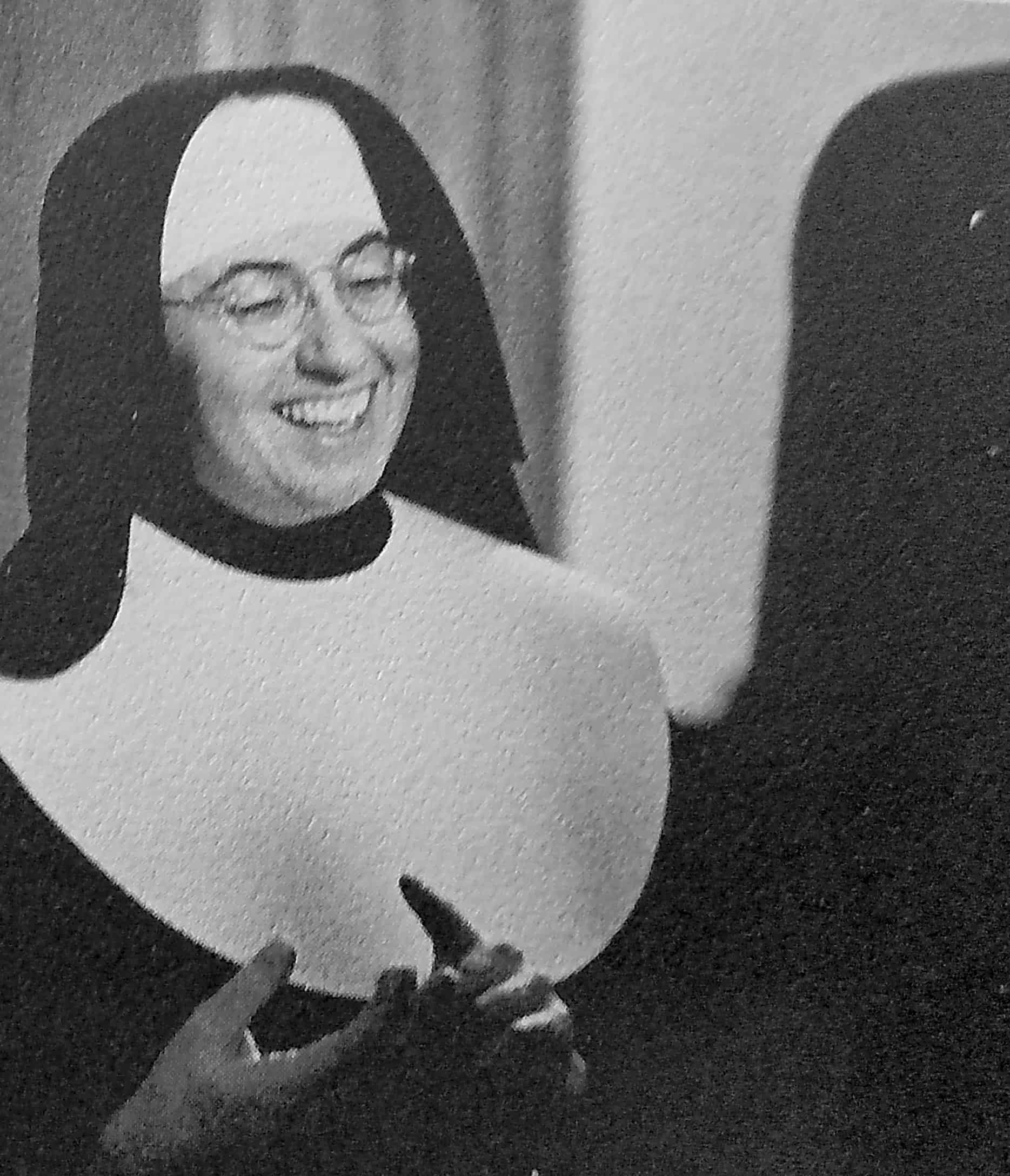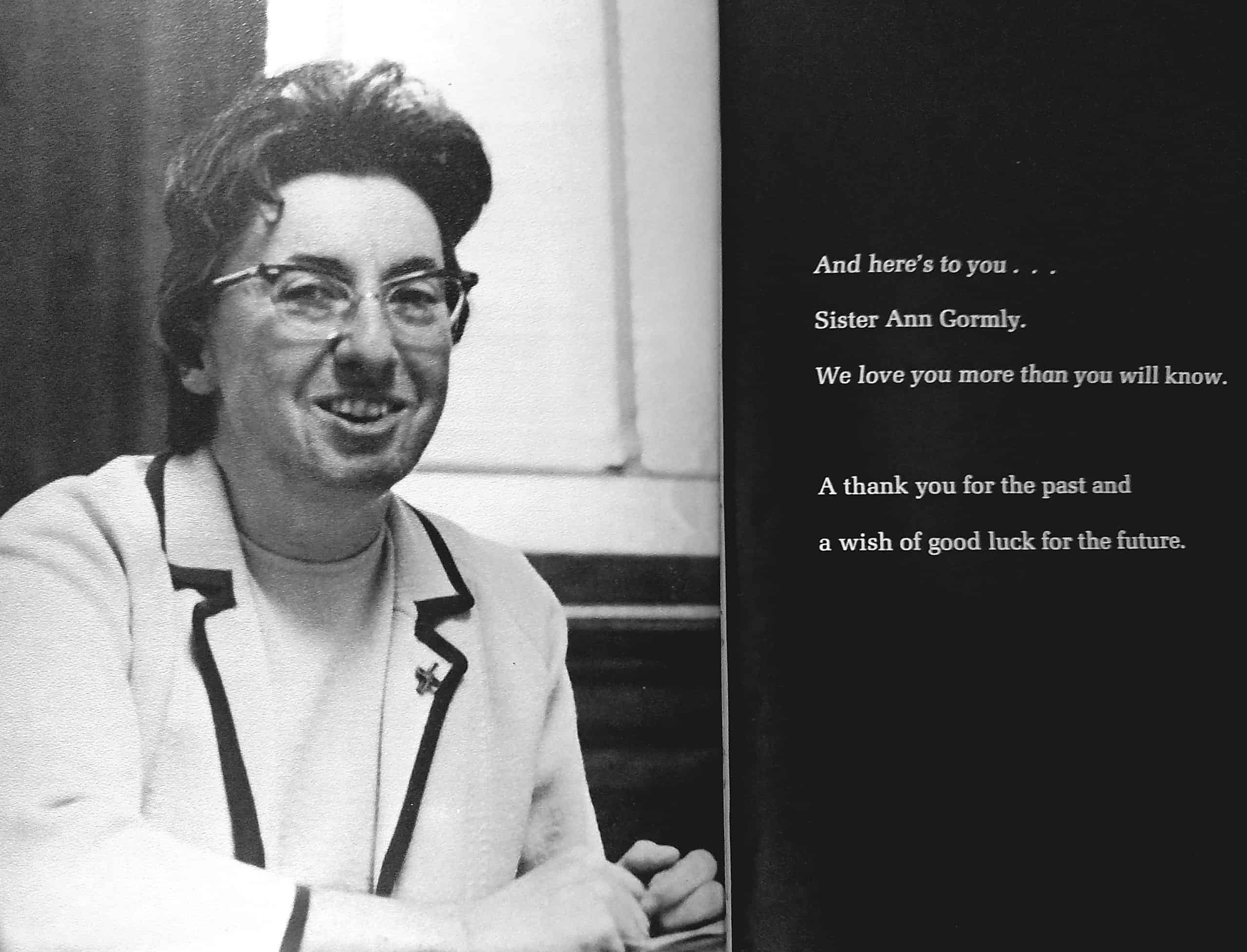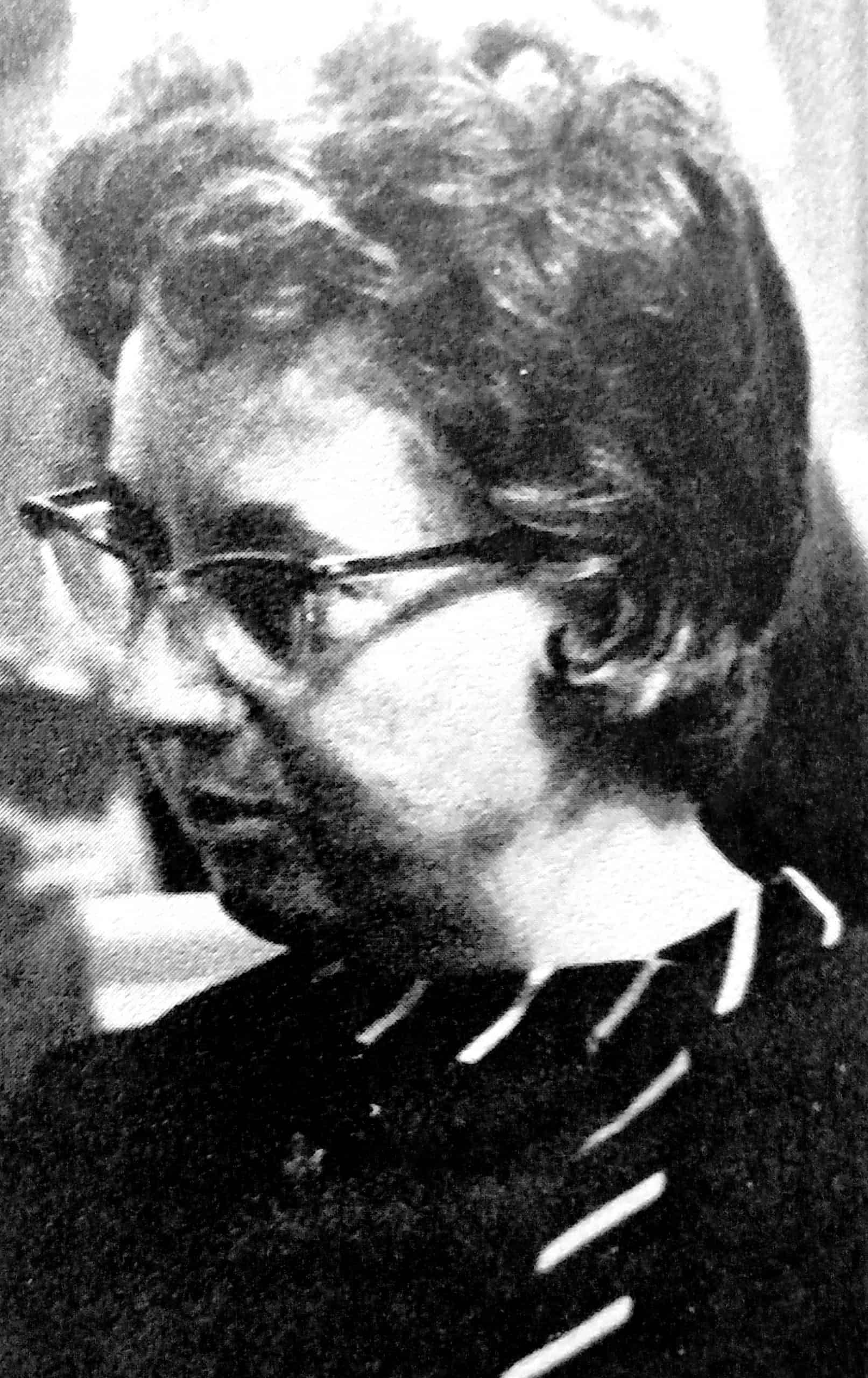
Remembering Sr. Ann Gormly ’45 SNDdeN

(Sr. Ann Gormly, SND, Class of 1945, in the dedication of the Class of 1971 yearbook.
Sr. Ann was then Dean of Students as well as Chair of the Department of Spanish)
When the Greens of ’74, my class, descended on Trinity’s campus in the Fall of 1970, we were very afraid that the revolution had already passed us by, so we set about making sure that we had our fair share of questioning authority and demanding liberation. Woodstock was already two years gone; the Vietnam war was raging, and Kent State was fresh in our minds. Demonstrations for civil rights had grown larger and more urgent after the assassination of Dr. Martin Luther King, Jr., and Washington was still reeling from the riots of 1968. Trinity, itself, had seen a student strike in the spring of 1970. Our older sisters, so worldy-wise, seemed wired into all of the best protest demonstrations and “happenings” in Washington. But we freshwomen were constrained by curfew hours and no-visitors policies as the senior officers and Sisters on the scene in Main Hall tried to wrassle our most unruly class into something resembling a civilized group of Trinity Women. Most of us lived on the third and fourth floors of Main Hall in those days, with the most memorable episodes of our formative first year at Trinity taking place on the upper floors, the Marble Corridor and in Social Hall.
And so the day came when we were summoned to Social Hall for an important meeting with the Dean of Students. As we entered and took our places lounging mostly on the floor, we noticed something awry: all of the paintings that normally hung on the walls in Social Hall were gone! What was this?
 Enter Sister Ann Gormly, SND, the Dean of Students. She stood before us, silent, seemingly seething, leveling her fierce gaze at each of us as she looked around the room and then pointed to the empty walls. “You will not leave this room until those responsible come forward,” she said (or words to that effect, it’s been a long time since that day…) Murmuring ensued among the Green Class of ’74. Who was so nefarious as to remove the paintings? Some of us already had gained some notoriety in other escapades — shooting water pistols down the Well or stealing curtains from showers or sneaking into the convent kitchen for ice cream — rather harmless diversions from long nights under curfew. But stealing the paintings from Social Hall? Unthinkable!
Enter Sister Ann Gormly, SND, the Dean of Students. She stood before us, silent, seemingly seething, leveling her fierce gaze at each of us as she looked around the room and then pointed to the empty walls. “You will not leave this room until those responsible come forward,” she said (or words to that effect, it’s been a long time since that day…) Murmuring ensued among the Green Class of ’74. Who was so nefarious as to remove the paintings? Some of us already had gained some notoriety in other escapades — shooting water pistols down the Well or stealing curtains from showers or sneaking into the convent kitchen for ice cream — rather harmless diversions from long nights under curfew. But stealing the paintings from Social Hall? Unthinkable!
Sr. Ann left the room abruptly, and I don’t recall how long we sat there, but eventually, obviously, someone — several some ones — came forward to confess the Grand Theft of the Paintings. They didn’t really steal them, they just moved them to another room, hoping, perhaps, that the Class of ’74 would be invited to decorate Social Hall in our own style. Sr. Ann Gormly (and Sr. Margaret Claydon, our president then) were not amused. I think some of our classmates had their curfews extended for quite a long time (being “campused” was the ultimate punishment in those days!).
 Looking back on what now seems to me to be a somewhat hilarious episode — and with the insight that comes from being an administrator, myself — I think that rather than glaring at us, Sr. Ann Gormly was about to burst out laughing at us, and her hasty exit from the room was to save her from doing so in front of us. She was the Dean, after all, and had to present a stern face to a chronically disruptive group. But as the year went along, we began to see another side of Sr. Ann, one that endeared her to generations of Trinity alumnae.
Looking back on what now seems to me to be a somewhat hilarious episode — and with the insight that comes from being an administrator, myself — I think that rather than glaring at us, Sr. Ann Gormly was about to burst out laughing at us, and her hasty exit from the room was to save her from doing so in front of us. She was the Dean, after all, and had to present a stern face to a chronically disruptive group. But as the year went along, we began to see another side of Sr. Ann, one that endeared her to generations of Trinity alumnae.
She was a teacher as well as an administrator, the chair of the Spanish Department. She was exceptionally progressive at a time when Trinity was emerging from its long traditions of an older age into a modern world where the counterculture was defying all norms, where the Church was in upheaval after Vatican II. She was Dean at a time at Trinity of great change, internally and externally.
She was responsible for the orientation and formation of new classes of students who were influenced by the liberalizing forces of the 1960’s, women who no longer just accepted rules as the way things were, women hell bent on making new rules. Rumor had it that she kept cash in her desk drawer in case students who went to antiwar protests downtown needed bail money. She was philosophically aligned with the antiwar movement, the quest for social justice, the urgent need for peace at home and abroad.
She initiated service trips to impoverished people in Honduras in central America. She was a Sister of Notre Dame who stayed true to her vocation even as many others questioned religious life and chose other paths. She found new pathways for her own vocation, leaving Trinity after 1971 to pursue work in SND administration, and then with the U.S. Catholic Mission Association, and later with Healthcare for the Homeless. She continued teaching in her later years, always focused on teaching in ways that would bring help and hope to those in need.
Sr. Ann Gormly died on January 8, 2021 at Mount Notre Dame in Cincinnati. Because of the pandemic conditions, we could not have a celebration of her life at Trinity. But we plan to do so as soon as we are able to convene again, probably in the fall or next spring. Meanwhile, many alumnae are sharing fond memories of Sr. Ann — below are alumnae memories, and I welcome more (send them to president@trinitydc.edu or enter yours in the comment box).
Alumnae Memories of Sr. Ann Gormly ’45 SND
Narcissa (Ching) Escaler ’66: I am deeply saddened with the passing away of one of the dearest friends of my life, Sister Ann Gormly. She was my Spanish teacher at Trinity College when I was a freshman in 1962 and we enjoyed a close and warm friendship throughout these past 59 years together with Sister Seton in spite of my two short years at Trinity.
Despite the distance between the US and the Philippines and the work we did over the years which took us all over the world, we remained in close contact. Sister Ann even came to visit me in the Philippines and met my late husband, children and my whole family. She followed closely the unfolding events in my country when, as a young widow, I joined the fight against the dictatorship and helped install President Corazon Aquino as President. She was thrilled when I joined the office of President Aquino and later served as her Ambassador to the United Nations in Geneva and New York in 1989. She and Sister Seton came to visit and stayed with me and my children in Geneva in 1990 which was truly a memorable reunion.
I visited Sister Ann and Sister Seton very often all these past years, and even spent many evenings in their home on Quincy St. in DC whenever I would come to the US – the last one being a wonderful take out lunch at their new apartment in DC at the end of March 2019.
After they moved first to Villa Julie and then to Cincinnati in mid 2019 I completely lost touch with both Sister Ann and Sister Seton in spite of my repeated attempts to reach them. It was only recently when a former TC classmate of mine relayed the very sad news of Sister Ann’s passing. It was one of the saddest days of my life.
I loved Sister Ann deeply and will miss her terribly. She was a wonderful teacher, a role model and a true and dearest friend. But I know she is now at peace and in the arms of Our Lord and His Blessed Mother.
I wish to express my heartfelt condolences to Jean, Charlie and Paula Gormly and to Sister Seton, for their great loss and assure them of my continued prayers.
Susan Widmayer ’68: I was blessed to know Sister Ann for almost 60 years from my first days at Trinity in 1961. In addition to being my Spanish Professor, she sat in the office adjacent to the side door in the Main Building through which students entered when they came in after 8 PM . I worked in the Library and Sister Ann greeted me when I returned just about every night.
I had decided to take Spanish because, even after nine years of instruction, my French was still terrible and I had hoped that I might do better in another language. Every day for many months, I went to the Language Lab and practiced that day’s lesson. Sr. Ann would see me there and occasionally ask how I was doing. Eventually she stopped asking as she knew how hopeless my efforts were.
At the end of May of my freshman year, Sr. Ann asked if I would stay after Spanish class. I stayed, but with much trepidation as I knew I was doing so poorly and Trinity required facility in a Modern Language for graduation. The last thing I wanted to do was try to take Spanish or any language for another year and I knew I was failing .
Sr. Ann’s solution was that I take Spanish at American University, near my home, during the summer. The A.U. program emphasized facility in reading and translating with no conversational requirement. That summer I “Aced” the required text on the life of St. Rose of Lima which Sr. Ann ultimately made acceptable for my Trinity requirement.
I had not thought of the kindness that Sr. Ann had shown me for several years until earlier this month, on January 8th, when neighbors and I were sitting on the driveway, as we “shelter in place,” and someone mentioned facility with languages. Surprisingly to me, I told everyone what my wonderful Spanish Professor had done for me.
I learned later that Sr. Ann had died that day. Maybe her new “presence” in my life somehow reminded me how wonderful she and Trinity were to me so many years ago.
Maggie Raffa ’60: Sister Ann Gormly was a wonderful Spanish teacher for me. May she rest in the comfort of Jesus’ sacred hands.
Martha Knight ’67: Being in Sister Francis'(Ann’s) course, we got to talking about travel to Honduras, my mothers country that I had visited the summer before coming to Trinity (my high school graduation present). Sister Ann became more and more interested in the possibility. After my mother contacted her friends there who were happy to host the students, it was a go. The group of students from various classes went the first time in 1965 and had memorable experiences, staying with families, working in projects helping banana workers and workers in the city (San Pedro Sula) and the public hospital, Leonardo Martinez. We observed the conditions of poverty as well as the warmth of the people and our host families and in visits to the capital and the Bay Islands where we got to know the British descendants there… Sister Ann went on to a significant career with international involvement. Sister Ann was a warm easy personality and enjoyed all of us. The trips to Honduras had pivotal influence in some of the students, who went on to become missionaries, teachers and journalists to name a few of the professions.
Maria Alvarez ’67: I entered Trinity in the fall of 1963 as an international student from the Dominican Republic. We international students were immediately drawn to Sister Francis. She organized field trips to help us become acquainted not only with the area but with American History. Thus, we visited Gettysburg, Williamsburg, Arlington, and many other important landmarks in the DC area; in the process we became acquainted with one another, as there were students from many different countries and native languages studying at Trinity. For Spanish-speaking internationals, Sister Francis made it possible for us to attend lectures and activities at Trinity and DC area featuring important writers and poets from Spain and Latin America. Her reaching out was very important to us and expanded our scope. I shall always be grateful.
Katherine (Karen) Lordi ’71: She was a very dedicated Dean of Students and she made her appreciation of us well known. She was always ready to guide and advise us and – in true Trinity style – always ready to party with us too!
Chris Casey Rath ’68: I traveled to Honduras and to Spain with Sister Ann (then Sister Francis) as well as labored many hours in that language lab! So many happy memories as she introduced us to the culture, heritage, language and to the concept and experience of service to others. (I won’t tell about the time we all got locked out on the balcony of a hotel and one of us had to climb along the ledge to get in a neighboring room.) She was a friend and mentor…
Eileen Grieve Stokes ’73: The loss of Sr. Margaret Claydon and Sr. Ann really signals the end of an age at Trinity. While I never had Sr. Ann as a teacher, she and Sr. Margaret were the two anchors of Trinity in the 1960s and 70s. My most meaningful memory of Sr. Ann is of my weekend visit to Trinity as a high school senior. I was visiting for a long weekend. I attended a class (I don’t remember whose), I had an appointment at the Development Office (I don’t remember much), and I had an interview with Sr. Ann in her office off the Marble Corridor. That I do remember. And I returned home sure that Trinity had moved up to #1 on my college choice list. Another memory during my years at Trinity is of Sr. Ann’s smile. She did seem especially to enjoy the Trinity traditions — the class days and well sings in particular.
Kater Nicholson Pendergast ’67: What an amazing life for Sr. Ann Gormly! I knew her well– from Spanish class and as Dean of Students but especially from her leadership of the 1966 Honduras Summer group that gave all of us who participated a striking understanding of a world so different from our own. At Trinity and afterwards, she brought her drive to action to all she did and enjoyed new people and cultures and relished travel. I was fortunate to visit with her most recently in the fall of 2019 for a delightful lunch at the residence in Maryland with her dear friend Sr. Seton Cuneen “65. May she rest in peace.
Some Twitter memories of Sr. Ann:
Ann was a great promoter of missionaries through her leadership of USCMA. https://t.co/4vQ25AVMsy
— Friends in Solidarity (@FIS_SSudan) January 24, 2021
It is with a heavy heart that we announce the passing of Sister Ann Gormly ('45), @SNDdeN. She passed on January 8, 2021, at the @SNDdeNOhio in Cincinnati. @TrinityPrez invites alumnae to send memories for a blog post to president@trinitydc.edu https://t.co/kikTnkUyD7 pic.twitter.com/NTMNZv8aCf
— Trinity Washington U (@TrinityDC) January 22, 2021

(Sisters of Notre Dame in 2017, above, at the dedication of the portrait of Trinity Founder Sr. Julia McGroarty on the Marble Corridor.
Sr. Ann Gormly is seated in the center.)
2 Comments